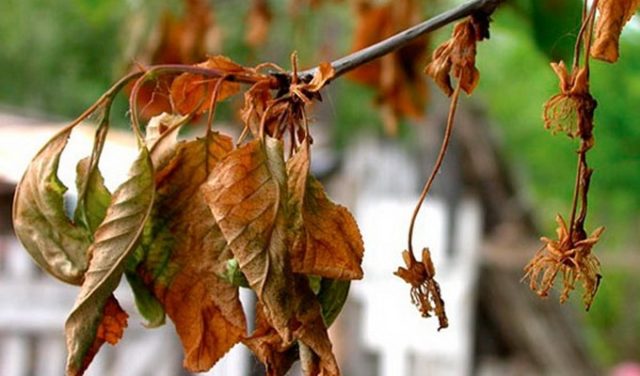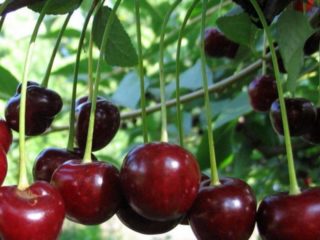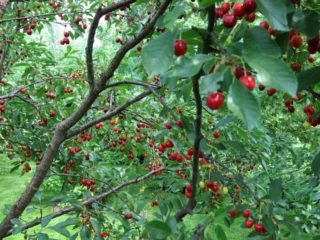Content
Cherry Bystrinka is the result of the work of breeders from the All-Russian Research Institute. To obtain a tree, the varieties Cinderella and Zhukovskaya were crossed. In 2004, it was entered into the State Register.
Description of Bystrinka cherries
The variety was developed by breeders for cultivation in the Central zone of Russia. It grows and bears fruit successfully in more southern regions. In areas with a cold northern climate, under certain conditions, Bystrinka cherry also grows, but the yield will be much lower than expected.
Height and dimensions of an adult tree
The Bystrinka cherry variety is classified as undersized. According to the photo and description, it is capable of reaching up to 2-2.5 m in height. His crown is quite thick, similar in shape to a ball, slightly raised.
Shoots of medium length, straight. Their color is brown and brown. Lentils are yellow in color and medium in size, in small numbers. The bud in the form of an oval is deflected from the shoot to the side.
The leaf plates of Bystrinka cherries are oval in shape with a pointed top, green in color.
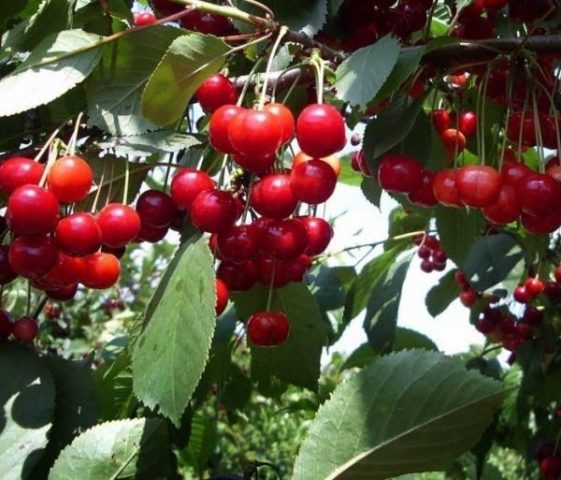
On the edges of the leaf of the Bystrinka variety, there is jagging, and it itself has a slightly wrinkled surface that bends downward
The petiole is thin, reaching 16 mm in length. The inflorescence consists of 4 flowers, appears at the end of May.
The rim of each of them reaches a diameter of 21.5 mm, has a saucer shape. The petals are white, in contact with each other. The anthers are located higher in relation to the stigma of the pistil. Bystrinka's cups are presented in the form of bells with strong notches.
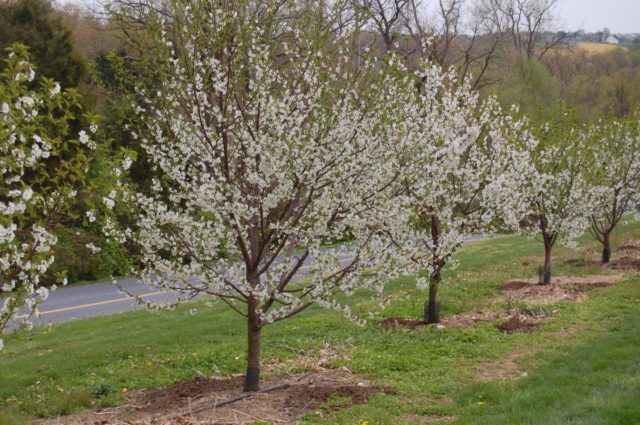
Ovary and berries are formed on annual branches or bouquet shoots
Description of fruits
Cherry Bystrinka has an oval shape, its weight varies from 3.4 to 4.2 g. The color of the berry is dark red. The pulp is the same shade inside, it is very juicy and elastic to the touch. The inside of the berry is dark red juice. A stone weighing up to 0.2 g, which is 5.5% of the mass of a cherry. It is yellow in color with a rounded top; when pressed, it easily separates from the pulp. The peduncle is of medium thickness, reaching 26 mm in length.
According to the tasting assessment, the Bystrinka cherry variety was assigned 4.3 points. The pulp inside is tender, sweet, but with a slight sourness.
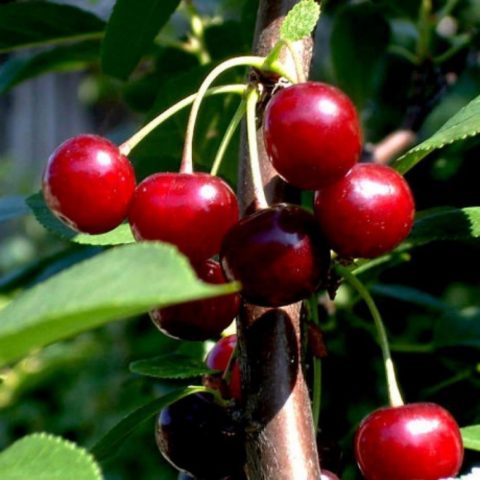
In fruits, 12.8% is dry matter, sugars account for up to 9.9%, and the percentage of acids is 1.3%
Cherry pollinators Bystrinka
According to the description and reviews of Bystrinka cherry, the variety is self-fertile, so planting pollinators on the site is not required. But their absence negatively affects the yield and the timing of fruit ripening.
The best option is to arrange the Turgenevskaya variety in the neighborhood. It blooms in mid-May and bears fruit in July.
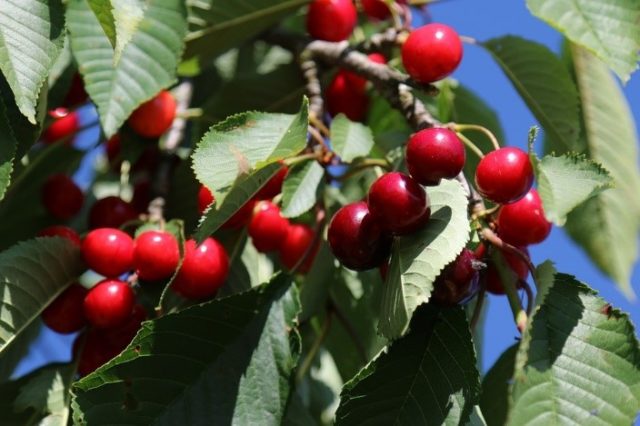
The flowers of the tree do not tolerate spring frosts and temperature changes.
The Kharitonovskaya variety is also suitable as a pollinator. It is distinguished by its drought resistance and average frost resistance.
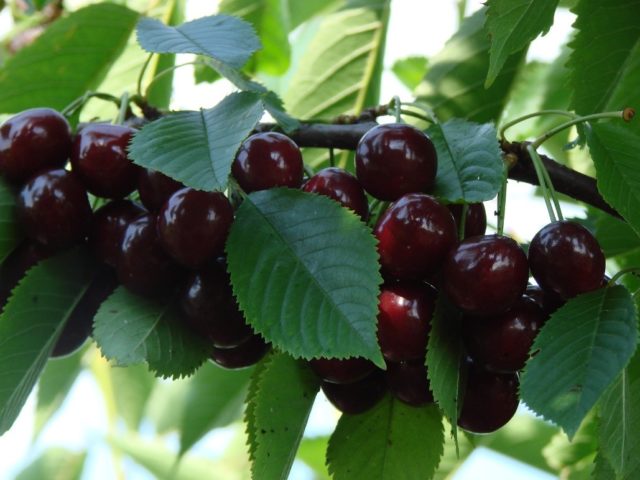
Flowers appear in late May and can be harvested from mid-July
Main characteristics
Cherry Bystrinka is a representative of mid-season varieties. It is unpretentious in care, but it is highly productive.
Drought resistance, frost resistance
Cherry Bystrinka is distinguished by good resistance to lack of moisture and unpretentious care. The tree safely survives medium frosts: up to - 35 ° С. Flower buds are not afraid of lower temperatures.
Yield
The variety ripens early: the first flowers appear in mid-May, and the harvest can be harvested from the last week of July.
Despite self-fertility, a high yield is ensured if pollinators are located next to Bystrinka cherries: up to 80 centners of berries are harvested from one hectare.
The harvested crop can be eaten fresh, or it is used for compotes, preserves or other preparations. Preserves the appearance and taste of frozen cherries.
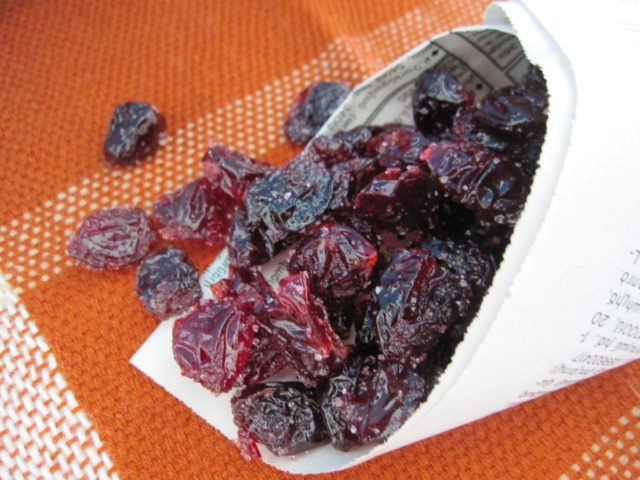
Drying of berries is also possible: the procedure avoids the loss of the beneficial properties of the fruit
Advantages and disadvantages
Among the main advantages of value among gardeners are the high yield and compactness of the tree.
Advantages of the variety:
- high taste characteristics;
- unpretentious care;
- early maturity;
- high transportability of the crop.
Among the disadvantages of Bystrinka cherries is susceptibility to fungal diseases: coccomycosis and moniliosis.
Landing rules
Despite the unpretentiousness of the variety in care, Bystrinka cherries bear fruit more abundantly, if you initially choose the right place on the site and plant a seedling. The procedure should be carried out taking into account the composition of the soil in the garden and climatic features.
Recommended timing
In the southern regions, the optimal time for planting is autumn. In areas with a more northerly climate, it is recommended to transfer seedlings to open ground in the spring. When choosing a planting date, it is required to take into account that the tree needs time for its root system to strengthen and survive the winter safely.
Site selection and soil preparation
Cherry Bystrinka is an unpretentious variety; it bears fruit successfully on loamy or sandy loam soils equipped with a drainage system. The acidity of the soil should be neutral. On oxidized soil, the tree grows poorly and often dies.
On the site, a place should be allocated for a tree on the south side, protected from the wind. It should be located at a low elevation: the required depth of groundwater flow is at least 2.5 m.
Before purchasing a seedling, it should be inspected: it should have a closed root system, there should be no cracks, growths or peeling on the trunk and branches.
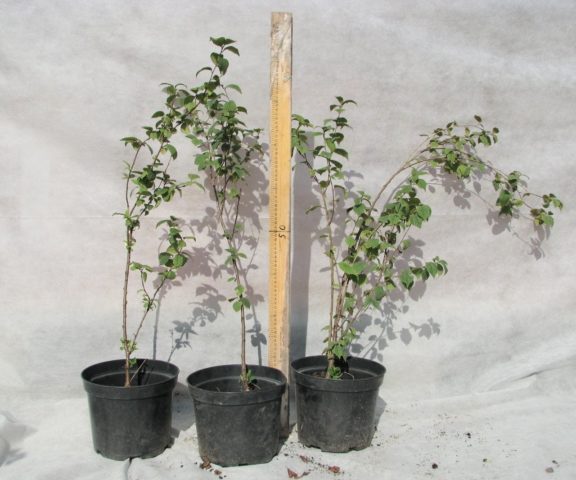
A one-year-old seedling must have one central trunk with a diameter of at least 1.5 cm
How to plant correctly
The procedure should begin with preparing the pit. It should be 60 cm deep and 70 cm wide. If you want to plant several seedlings, then it is important to maintain a distance of 2.5 m between them.
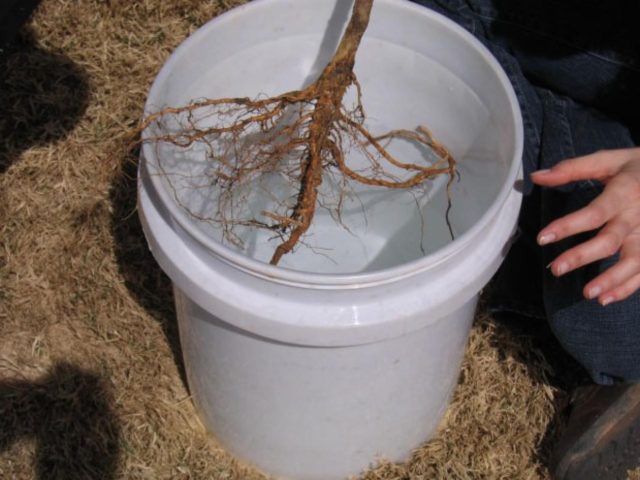
Preliminary preparation for planting a young seedling is to soak its roots in growth stimulants (Epin, Gaupsin) for 4 hours
Algorithm for transferring Bystrinka cherries to open ground:
- in the center of the hole, drive a wood peg to a height of 2 m to create a support for the cherry;
- place top dressing on the bottom of the hole (mix 1 liter of ash with 5 kg of compost and 30 g of superphosphate);
- transfer the seedling to the hole, make sure that the roots are straightened, and the root collar protrudes 3-4 cm above the surface of the hole;
- cover with soil, compact the soil around the seedling and water (up to 2 buckets for each tree);
- mulch the land using peat or sawdust.
Care features
It depends on compliance with the rules of agricultural technology whether the seedling will root successfully. Timely watering and feeding, as well as disease prevention are the key to abundant fruiting.
Watering and feeding schedule
No fertilization is required for 2 years after transplanting the seedling. The fertilizing schemes are different: in the spring, before the flowers bloom, watering is carried out with carbide. To do this, dissolve 30 g of the substance in 1 bucket of water. In autumn, rotted manure should be added to the tree trunk circle at the rate of 3 kg per m2.
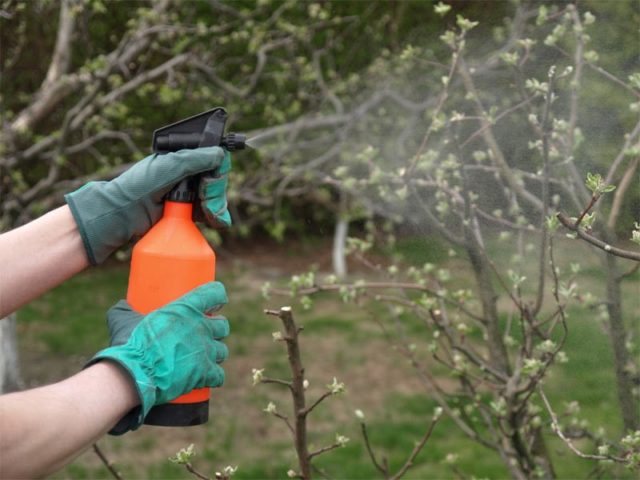
During the flowering period, for the formation of a larger number of ovaries, the crown should be treated with boric acid, diluting 10 g of the drug in 10 liters of water
Young seedlings are demanding for watering: the soil should be moistened every 14 days, and during periods of drought, twice a week.
One cherry tree of the Bystrinka variety requires 10 to 20 liters of water. If the air temperature drops or rains become more frequent, then there is no need to moisten the ground.
Pruning
Cherry Bystrinka is a low-growing variety, so it needs regular pruning. The procedure is carried out after the snow melts, before bud break.
Formation should be carried out in the first year after planting in open ground. Annual seedlings must be shortened to the point where branching is expected. The cut should be straight, 5 cm above the kidney.
For two-year-old cherry seedlings of the Bystrinka variety, up to 8 skeletal branches should be left during pruning, then shortened by 1/3 so that there is no extra growth. In subsequent years, it is necessary to remove weak or damaged branches.
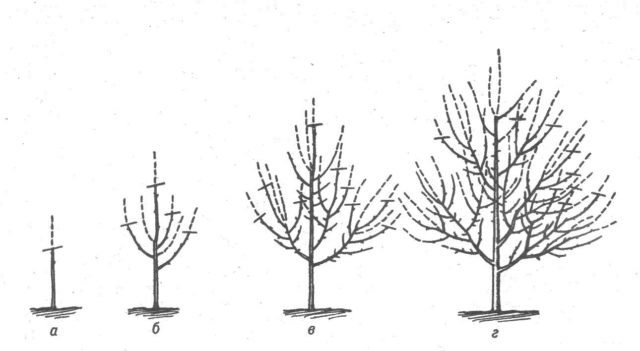
It is recommended to remove the shoots on the trunk in the spring or summer months.
At the end of the procedure, all sections should be treated with garden varnish, otherwise the tree's immunity will weaken.
Preparing for winter
A young tree should be prepared for the upcoming frost: whitewash the trunk, collect and burn all fallen leaves, fill the trunk circle with mulch. If the growth of the cherry allows, then it can be completely wrapped in a covering material.
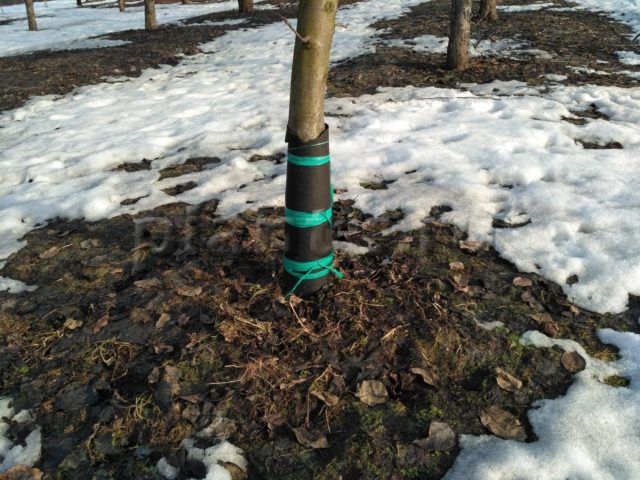
It is enough to whitewash mature trees or cover their trunks with improvised means from rodents, the Bystrinka cherry variety is not afraid of frost
Diseases and pests
The variety is susceptible to diseases caused by fungi. The main types of infections: fruit rot, cocomycosis, curliness of leaf plates, perforated spot, anthracnose.
It is necessary to regularly remove weeds and rotten leaves around the tree, loosen the soil around the trunk circle. Flowers should be sprayed with Bordeaux liquid, after diluting 200 g of the substance in 10 liters of water.
If there are signs of a disease of the variety, the color of the leaf plates has changed, they curl or fall off, the tree suddenly stops growing and bearing fruit, then the cherry should be treated with fungicides.
To prevent an attack by aphids, sawflies or cherry moths, the cherry should be sprayed with Aktofit or Bioreid. If they are ineffective, it is recommended to use insecticides.
Conclusion
Cherry Bystrinka is a high-yielding variety that is easy to care for. The tree is short, so it can be grown in small garden plots. The harvested crop is versatile in use, both for personal purposes and in industry.
Reviews of gardeners about Bystrinka cherry
